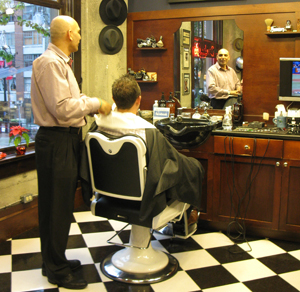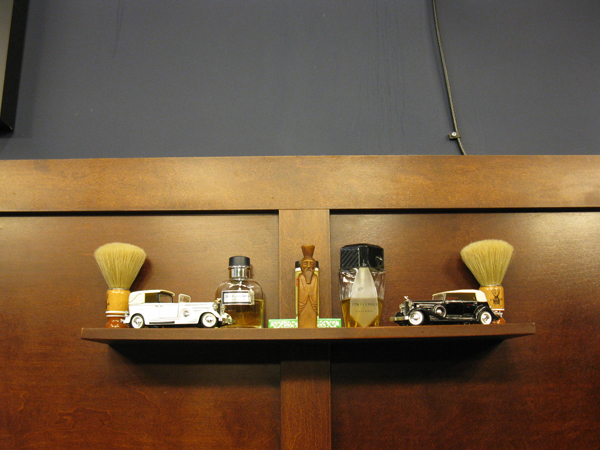
Seated next to me at the bar in The Ascot in Vancouver's hip Gastown neighbourhood, Jesse Lockhart, a 36-year-old barber, watches a disheveled and soggy hockey player on the television mounted next to a deer head above. He grumbles about the state of playoff beards.
To the untrained eye, Lockhart's face is bushy and unkempt; however, upon closer inspection, the sides of his beard appear sharp and angular, and his copper-coloured curlicues are trim. Today his tendrils are tucked beneath a black toque, which matches the rest of his cat-burglar apparel. This is the new face of the barber.
Once considered a dying profession, barbering's resurrection in metropolitan cities across North America over the last half decade is apparent. In Vancouver, quaint barber shops adorned with the red, white and blue barber's pole are sprouting up faster than car-sharing services.
But no longer is today's barber shop owned by a grandfatherly dude who has worked every day since the age of 12. It was never frequented by your father or your father's father, because it just arrived on the scene. And it certainly doesn't offer the two-pence shave and cut.
What is the same, is the trade itself. Barbering is still a class act.
Razor-wielding street cred
"I'm a traditional barber in a salon," explains Lockhart, who spends his working days at the Bangtown Hair Saloon. The salon recently added a men's chair offering the gamut of classic barbering services, like cuts and straight-razor shaves. A straight-razor shave is an old-school method of hair removal that uses a knife-like blade that folds into its handle. The blade is used to shave the hair in the same direction as its growth -- this is the "first pass." Optional is the second pass, another shave opposite the direction of the hair growth known as the gentleman's shave.
"At the time I was looking for something to base myself in, to focus my energy in a career that was recession-proof, slow but steady, that was respected, that is tried and true... I was looking at old-school trades because they were something that interested me a bit more. Something that's that old, that's still around, still useful, still applied in modern day, is fascinating."
It's definitely old school. Razors are among ancient artifacts found thousands of years before Christ.
The word barber comes from the Latin word barba, meaning beard. Razor-wielding men have enjoyed a certain level of street cred throughout history, particularly in the Middle Ages when barbers also performed some surgical work, like bloodletting and dentistry (they extracted teeth). These "barber surgeons" would wrap red and white cloths (indicating blood and bandages) around a pole and place them outside of their establishment to advertise their services. Thus the barber's pole was born, but where and when the blue that made its way into the modern barber's pole colour scheme came into play is anybody's guess.
"The blue I've heard represents the blue veins. I've also heard that it represents water. I've also heard other things where they say that became a more American thing. I've heard and read but I don't know of any definitive answer why the blue came in. Historically the red and white [pole] is the original. That goes back to the days when barbers did bloodletting and teeth-pulling," says Shelley Salehi, co-owner of Farzad's Barbershop in Yaletown and wife of Farzad.
Farzad's Barbershop opened in 2006 and is reminiscent of the old-timey barber shop, but inflected with notes of modernism. A flat-screen TV showing cartoons sits between the only two chairs in the shop. A Moto Guzzi motorbike leans against the wall to my right. I examine the black-and-white floor tiles while Salehi greets a client by name. Farzad is clipper-cutting the hair of a gentleman and simultaneously telling a story using animated gestures. His assistant Noriko Matsuguchi holds a buzzing clipper over an apprehensive little boy. Pieces of board protruding from the walls serve as shelves and selectively placed on them are miniature Depression-era cars and motorcycles.

"There's definitely been a resurgence over the last couple of years. I think in a way it's almost a kind of backlash to the salon environment where guys are wanting to get back to things their grandfathers used to do and that whole nostalgic feeling that a barbershop evokes. They're wanting a more male-oriented environment... To me a real barbershop is just your basics like men's haircuts and straight-razor shaves -- which is something a lot of salons don't offer," says Salehi.
Farzad finishes off the haircut with a straight-razor shave to the back of neck. When it is smoother than a waxed limb, Farzad swivels the chair around 180 degrees, drops the back and washes the clients hair in a deep, black porcelain sink, so that his customer may go about his day free of pesky little clipped hairs.
Back to the classics
Over the past few decades barbering fell under the shadows of emerging glitzy and luxe salons proffering celebrity haircuts and high-grade hair products. Salons not only bill runway hair designs; they sell a lifestyle at a relative price.
The smooth and effective shave of the straight-razor came under attack from King C. Gillette's double-edged safety razor with replaceable blades, which was patented in the early 20th century. At-home razors and electric shavers had been around for some time, but the convenience and ease of disposable blades made shaving less intimidating for men, and their growing popularity revolutionized the industry, pushing the straight razor close to retirement.
Savvy entrepreneurs from leading brands like Nivea, Dove and Neutrogena soon had drug stores carving out shelf space for products geared towards image-conscious gents. But has the personal care market that cropped up so quickly thrived or lost its luster over time? The latter, according to one proprietor's experience.
Graham D. Bingham, co-owner of Momentum Grooming, started his handsome little shop eight years ago as a retail store for men's aesthetic products. In 2006 he added barbering services.
"When we opened the store, no major player was really tapping into the men's market at that point. There was Clarins and Clinique for men, that sort of thing. They were essentially taking the core women's products and re-packaging it for men... Now fast-forward eight years, there is a huge abundance of for-men products in drug stores and department stores. I'm sure a lot of them are having some degree of success and they have the marketing money to put behind their brands.
"2004 was the height of the metrosexual trend… It was driving where products were going at that time and after we opened the store, we could really interact with clients and realized that wasn't the growth area. The growth area was going back to the classics. Young men today want the double-edge safety razors, the straight razors, they want the traditional feel their fathers and grandfathers had. We've completely changed the direction of the company to reflect that as opposed to more modern things."
Barbering has stood the test of time and is, once again, back by popular demand.
What's next? Butchering? ![]()
Read more: Local Economy















Tyee Commenting Guidelines
Comments that violate guidelines risk being deleted, and violations may result in a temporary or permanent user ban. Maintain the spirit of good conversation to stay in the discussion.
*Please note The Tyee is not a forum for spreading misinformation about COVID-19, denying its existence or minimizing its risk to public health.
Do:
Do not: